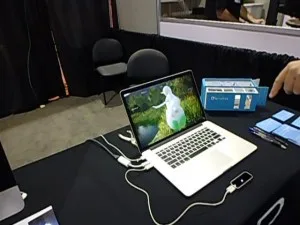3D in Education – In a previous article, Stereo Symbiosis Needed in the Education Market, I wrote that the growth trajectory of 3D will not accelerate to the degree desired without help from other, complementary technologies. 3D’s plus-one, if you will. “Only by joining 3D together in symbiosis with other enabling technologies will it be hoisted into commercial and educational prominence”, I explained. The German mycologist Heinrich Anton de Bary defined symbiosis as “the living together of unlike organisms”. In the field of life sciences, symbiosis is defined as a close and prolonged association between different organisms of different species that in some way benefit each other. In a sociological or psychiatric context, it refers more to a relationship of mutual benefit or dependence. And in modern business culture, we often refer to a memeplex, a combination of ideas that is more likely to survive and thrive together than apart. “In order to truly achieve its potential, I believe 3D will not stand on its own”, I stated. Today, I am more sure of it than ever. The future rests with 3D’s plus-one.
In my survey, I challenged readers to vote on my nominations for the most receptive combination as a 3D symbiont in the education space. I provided these five voting options:
3D + Gesture Recognition. “The eyes and hands have it.” Envision combining stereo 3D with the ability to control objects, navigation, or actions via natural hand gestures.
3D + the Cloud. “The cloud has left the building.” Imagine being able to deliver stereo 3D via the Internet, enabling 3D companies to dispense with the complexity, copy protection, installation and reinstallation schemes that so agitate customers. Putting 3D in the cloud will simplify the storage, delivery and frequent refresh of 3D learning objects and simulations.
3D + Volumetrics. “Dispensing with the fourth wall.” Imagine 3D combined with volumetrics, dissolving the barrier of the fourth wall and presenting a new type of “circle 3D”. (See the MiCoy Corporation for one group that has patented solutions in this area.)
3D + 4K. “Okay—it sounds like a math equation – I get it.” Nonetheless, will the combination of stereo 3D and the stark realism of a 4K resolution display produce the crowds and clamor we all hope for?
3D + Other. “3D done your way.” Perhaps there is another technology that makes sense as a symbiont with stereo 3D. What would you suggest?
Well, the survey votes are in and the winner for the symbiote-most-likely-to succeed is… gesture control. Does gesture control in fact hold promise as 3D’s plus-one, at least in the educational market? Apparently, it does. At the recent ISTE 2014 educational conference a demonstration booth offered by Leap Motion drew outsized crowds, along with the prerequisite oohs and ahhs, while demonstrating gesture control with known 3D modeling and visualization software. See these examples below.
Leap Motion at ISTE 2014 attracted significant attention
Also see this Video LINK
Hold on, now! Not so fast! I don’t agree with the tech heads and gadget geeks on this one. The Leap Motion Booth was indeed a sexy proposition as 3D’s potential plus-one, but my instinct says this was merely a gadget crush. In the education market, delivery outscores feature set:
But is delivery of stereo 3D by the Internet a chimera? I know of two companies working on this, and I can’t get sufficient information from them. It looks like we won’t know 3D’s plus-one until it really shows up at the party. – Len Scrogan

